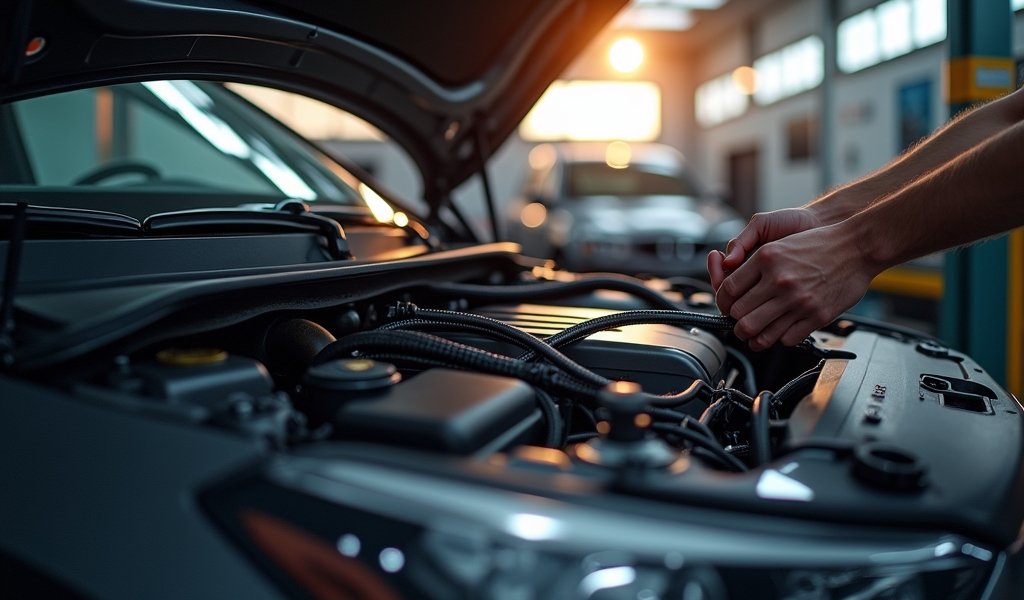Overview
This article identifies seven common car heater problems and their DIY solutions, including low coolant levels, clogged heater cores, faulty thermostats, broken blower motors, malfunctioning control valves, air in the cooling system, and failed temperature controls. It emphasizes that many heating issues can be fixed without professional help, potentially saving hundreds of dollars in repair costs while ensuring comfortable and safe winter driving.
Table of Contents
- Introduction
- 1. Low Coolant Levels: The Hidden Culprit
- 2. Clogged Heater Core: When Heat Gets Trapped
- 3. Faulty Thermostat: The Temperature Gatekeeper
- 4. Broken Blower Motor: No Air Movement
- 5. Malfunctioning Control Valves: Regulating Heat Flow
- 6. Air in the Cooling System: Creating Blockages
- 7. Failed Temperature Controls: Communication Breakdown
- Essential Tools for Heater Repairs
- Conclusion
- Frequently Asked Questions
Introduction
There’s nothing quite like the sinking feeling of turning on your car’s heater on a frosty morning only to be blasted with ice-cold air. I’ve seen that disappointed look on countless customers’ faces over my 20 years as a mechanic. A functioning car heater isn’t just about comfort—it’s essential for safety through proper window defrosting and maintaining driver focus in cold conditions.
The good news? Many car heater repair issues can be fixed without emptying your wallet at the repair shop. In this guide, I’ll walk you through the seven most common problems I encounter in my shop and how you can tackle them yourself. With basic tools and a bit of patience, you’ll have that cozy cabin feeling back in no time.
Let’s warm up to these fixes that have saved my customers thousands of dollars over the years.
1. Low Coolant Levels: The Hidden Culprit
Your car’s heating system operates using the same coolant that prevents your engine from overheating. When coolant levels drop, there simply isn’t enough hot fluid circulating through your heater core to warm the cabin. It’s often the simplest explanation for a cold cabin.
In my experience, about 40% of heating problems stem from insufficient coolant. Here’s how to spot and fix this common issue:
Warning Signs of Low Coolant:
- Lukewarm air despite maximum heat settings
- Temperature gauge reading lower than normal
- Sweet, syrupy smell inside or around your vehicle
- Engine temperature fluctuations or overheating
DIY Fix:
- Ensure your engine is completely cool before starting (wait at least 30 minutes after driving)
- Locate the coolant reservoir (a translucent plastic container with “min” and “max” markings)
- If the level is below “min,” carefully remove the cap
- Add a 50/50 mixture of the manufacturer-recommended antifreeze and distilled water
- Replace the cap securely and start the engine to check for improvement
If you find yourself frequently topping off coolant, you likely have a leak that requires attention. Check hoses, the radiator, water pump, and gaskets for signs of coolant escape. Addressing the root cause now prevents bigger headaches down the road.
2. Clogged Heater Core: When Heat Gets Trapped

The heater core is essentially a mini-radiator tucked behind your dashboard. Over time, rust particles, sediment, and other debris can create blockages that prevent warm coolant from flowing efficiently. In my shop, I’ve seen heater cores so clogged they resembled antique pipes.
You’ll notice this issue when your heat output gradually diminishes over time rather than failing suddenly. According to CarMD’s vehicle health studies, clogged heater cores account for approximately 18% of winter heating system failures.
Telltale Signs:
- Inconsistent heating (works sometimes, not others)
- Foggy windows that refuse to clear
- Sweet smell inside the cabin
- Damp passenger-side floor mat
Flush the System:
- Locate the heater core hoses near the firewall (where engine compartment meets cabin)
- Disconnect both hoses (have towels ready for spillage)
- Using a garden hose with moderate pressure, flush water through until clear water emerges
- Reconnect hoses with new clamps if the old ones show wear
- Refill the cooling system and remove any air pockets
This procedure can save you $500-$1,000 compared to professional heater core replacement, which often requires disassembling much of your dashboard. I recommend flushing your coolant every 30,000 miles to prevent this buildup in the first place.
3. Faulty Thermostat: The Temperature Gatekeeper
Think of your car’s thermostat as a strict doorman. Its job is controlling when and how much coolant flows through the engine. When it fails, your heater’s performance suffers dramatically. I’ve seen customers spend hundreds on complex repairs when a simple $15 thermostat was the culprit.
A stuck-closed thermostat prevents proper coolant circulation, while a stuck-open one doesn’t allow the engine to reach optimal operating temperature. Both scenarios leave you shivering in your cabin.
Signs of Thermostat Problems:
- Engine temperature never reaches normal operating range
- Temperature gauge fluctuates unpredictably
- Heater only works after extended driving periods
- Overheating engine despite adequate coolant
Replacement Process:
- Locate the thermostat housing (typically where the lower radiator hose connects to the engine)
- Drain enough coolant to get below the thermostat level
- Remove the housing bolts and extract the old thermostat
- Install the new thermostat with the spring facing the engine
- Use a new gasket or appropriate sealant
- Reassemble, refill coolant, and check for leaks
This relatively inexpensive repair not only restores your heating performance but also protects your engine from potential damage. Make sure to use the correct temperature-rated thermostat for your specific vehicle—using the wrong one can cause ongoing temperature regulation issues.
4. Broken Blower Motor: No Air Movement
You can have all the heat in the world, but without a functioning blower motor to push that warm air into your cabin, you’ll still be cold. In my years fixing cars, I’ve seen plenty of perfectly functional heating systems rendered useless by a dead blower motor.
The blower motor is an electric fan that forces air through your heating system and into your cabin. They typically fail either due to electrical issues or because the motor itself burns out after years of service.
Diagnosis:
- No air from vents at any fan speed setting
- Grinding, squealing, or rattling noises when fan is activated
- Fan works only at certain speeds
- Burning smell from the dashboard area
Replacement Steps:
- Locate the blower motor (typically under passenger-side dashboard or in engine compartment)
- Disconnect the negative battery terminal for safety
- Remove any necessary panels to access the blower motor
- Disconnect the electrical connector and remove mounting screws
- Install the new unit and reassemble in reverse order
- Test all fan speeds before considering the job complete
A new blower motor costs between $50-$150 for most vehicles, plus a couple hours of your time. Having a shop perform this same repair could easily run $200-$400. Some blower motors have a separate resistor or control module that might be the actual culprit—always test the electrical components before replacing the entire motor.
5. Malfunctioning Control Valves: Regulating Heat Flow

The heater control valve acts like a faucet for your car’s heating system. It regulates how much hot coolant flows through your heater core based on your temperature settings. When it fails, temperature control becomes unpredictable or non-existent.
I’ve found that many drivers overlook this component because it’s relatively small and often tucked away out of sight. However, it plays a crucial role in your comfort during cold weather drives.
Symptoms of Valve Problems:
- Inability to adjust cabin temperature (either full heat or no heat)
- Temperature changes on its own without adjustment
- Visible coolant leaks around the valve area
- Engine cooling issues alongside heating problems
Valve Replacement:
- Locate the heater control valve (typically on a heater core hose near the firewall)
- Ensure engine is cool before beginning work
- Place a drain pan beneath to catch coolant
- Disconnect the valve, noting which hose connects where
- Install the replacement valve in the same orientation
- Refill coolant and test operation before finalizing
Modern vehicles may use electronic valves controlled by your climate control system rather than mechanical cables. These require testing with a multimeter to confirm proper operation. Either way, a control valve replacement typically costs $20-$100 in parts and can restore your ability to fine-tune cabin comfort.
6. Air in the Cooling System: Creating Blockages
Air pockets in your cooling system are the invisible enemies of proper heating. They prevent coolant from flowing smoothly through your heater core, creating hot and cold spots throughout the system. I’ve fixed countless “complex” heating issues that were simply air trapped in the cooling system.
After any cooling system service or repair, proper bleeding is essential. Research from the Society of Automotive Engineers indicates that even small air pockets can reduce heating efficiency by up to 30%.
Symptoms of Air in the System:
- Gurgling or bubbling sounds from the dashboard or engine
- Intermittent heating performance
- Engine temperature fluctuations
- Heat that works only after driving for a while
Bleeding Procedure:
- Park on level ground with the engine cool
- Fill the radiator or coolant reservoir to the proper level
- Start the engine with the heater on maximum and the cap removed
- Allow the engine to reach operating temperature
- Gently rev the engine to dislodge stubborn air pockets
- Top off coolant as needed and replace the cap once bubbling stops
Some vehicles have dedicated bleeder screws to simplify this process. Check your owner’s manual or service information for model-specific bleeding procedures. Modern vehicles with complex cooling systems sometimes require special tools or techniques to properly remove all air.
7. Failed Temperature Controls: Communication Breakdown
The days of simple cable-operated heater controls are largely behind us. Modern vehicles rely on electronic sensors, actuators, and control modules to manage cabin temperature. When these electronic components fail, your heater might ignore your commands completely.
In my experience, electronic control issues often present as intermittent problems—sometimes working perfectly, other times completely non-responsive. This makes diagnosis particularly challenging without proper testing equipment.
Common Control System Issues:
- Digital display malfunctions or shows incorrect information
- Controls that physically move but produce no temperature change
- Climate control that works intermittently
- System resets or changes settings on its own
Troubleshooting Approach:
- Check related fuses in both the cabin and engine fuse boxes
- Inspect wiring connections behind the climate control panel
- Reset the system by disconnecting the car battery for 10-15 minutes
- For mechanical controls, look for broken cables or disconnected linkages
- Test door actuators by listening for movement when changing settings
While diagnosing complex electronic issues may require specialized scan tools, many problems stem from simple fuses or loose connections. Start with these basics before assuming you need expensive components or professional diagnosis.
For vehicles with blend doors (flaps that control airflow direction), broken actuators are a common cause of heating issues. These small motors can typically be replaced individually without major dashboard disassembly.
Essential Tools for Heater Repairs
Before tackling these repairs, gather these essential items to make your job easier:
- Basic hand tools (screwdrivers, pliers, socket set)
- Proper coolant specified for your vehicle
- Drain pan for catching fluids
- Protective gloves to shield hands from hot components and chemicals
- Safety glasses to protect eyes from splashing fluids
- Shop towels or rags for inevitable spills
- Flashlight or work light for seeing in tight spaces
- Owner’s manual or repair guide specific to your vehicle
You can find most replacement parts at local auto parts stores, where staff can typically help identify the correct components using your vehicle’s year, make, and model. For specialized parts, consulting with a radiator repair service might save you time in sourcing the correct components.
Conclusion
A properly functioning heater transforms winter driving from an endurance test into a comfortable journey. The seven fixes we’ve covered address the most common issues behind car heater failures, from the simple task of topping off coolant to more involved procedures like flushing a heater core.
Remember that preventative maintenance remains your best defense against cold-weather surprises. Regular coolant flushes every 2-3 years, addressing small leaks promptly, and having your cooling system inspected during routine maintenance can keep you warm throughout even the harshest winters.
While these DIY repairs can save you significant money, know when it’s time to seek professional help. If you’ve tried multiple fixes without success, or if your vehicle has a particularly complex climate control system, consulting with a qualified mechanic might be your most efficient path to warmth.
Stay warm out there, and remember—understanding your car’s heating system not only saves money but also prevents that dreaded feeling of turning the dial to “hot” and getting nothing but cold air in return.
Frequently Asked Questions
How much does it typically cost to fix a car heater professionally?
Professional car heater repair costs range from $100 for simple issues like low coolant to over $1,000 for heater core replacement. The average repair falls around $300-$400 depending on your vehicle’s make and model.
Can I drive with a broken car heater?
You can drive with a broken heater, but it’s uncomfortable and potentially unsafe due to window fogging issues. If the problem is related to your cooling system, it could lead to engine damage if not addressed.
How long should a car heater take to warm up?
A properly functioning car heater should produce noticeable warmth within 5-10 minutes of starting a cold engine. Full heat typically requires the engine to reach normal operating temperature, usually around 10-15 minutes in cold weather.
Why does my car heater smell when I turn it on?
A sweet smell indicates possible coolant leaking from your heater core, while musty odors suggest mold in your ventilation system. A burning smell could point to an electrical issue with the blower motor or wiring.
How often should I flush my car’s cooling system?
Most manufacturers recommend flushing your cooling system every 30,000-50,000 miles or every 2-5 years. Check your vehicle’s maintenance schedule for the specific recommendation for your make and model.

